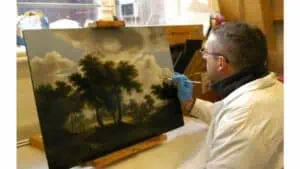Oil Painting Restoration-Evolution of Fine Art: Renaissance to Modernism

Oil Painting Restoration-Evolution of Fine Art: Renaissance to Modernism
The restoration of oil paintings is a captivating field that allows us to explore the intricate history of art and safeguard the magnificence of masterpieces for future generations to admire. From the Renaissance to the modernist movement, the progression of fine art has been truly remarkable. In this article, we will delve into the transformative expedition of art, shedding light on key periods and the substantial transformations that have shaped the art world as we comprehend it today.
Let’s commence our expedition with the Renaissance, a pivotal era in art history that birthed revolutionary artists like Leonardo da Vinci and Michelangelo. With their unrivaled creativity and technical mastery, these artists revolutionized the art world. Oil painting, a medium that gained acclaim in the late Middle Ages, flourished during the Renaissance. The use of oils enabled artists to portray depth and realism, resulting in exquisitely detailed and vibrant paintings. Nevertheless, as time passed and these masterpieces aged, many of them began to deteriorate, emphasizing the importance of oil painting restoration expertise.
The Baroque period witnessed a shift in artistic style and subject matter. Artists such as Caravaggio and Rembrandt introduced heightened drama and emotion into their paintings, captivating viewers with their play of light and shadow. However, as years rolled by, the brilliance of these works sometimes waned, necessitating significant restoration efforts to revive their original splendor.
Moving into the Romantic era, artists explored individual expression and imagination. This period saw an emergence of landscapes and scenes depicting the sublime beauty of nature. Over time, however, exposure to the elements and damage took a toll on these delicate paintings, requiring meticulous oil painting restoration work to breathe life back into them.
The Impressionist movement marked a substantial departure from traditional art forms. Visionaries like Claude Monet and Pierre-Auguste Renoir discarded conventional rules of perspective and detail, opting instead to capture fleeting moments and the interplay of light. While many Impressionist paintings have fared remarkably well over time, some have suffered from color fading and structural issues, necessitating careful restoration to rekindle their original allure.
The modernist era ushered in a period of boundary-pushing and questioning of artistic norms. Artists such as Wassily Kandinsky and Pablo Picasso created abstract and Cubist masterpieces, respectively, defined by innovation and experimentation. As time passed, the unique materials and techniques employed by these artists presented distinct challenges for restoration experts. Preserving and conserving these modern artworks demands a deep understanding of their original intent and the materials used.
Today, the field of oil painting restoration continues to evolve alongside advancements in technology and conservation practices. The development of new materials and techniques empowers restoration experts to tackle complex issues with precision and effectiveness. From cutting-edge imaging technologies to innovative cleaning methods, our ability to restore oil paintings to their former glory has reached unprecedented heights.
In conclusion, the evolution of fine art from the Renaissance to modernism has bequeathed us with an invaluable treasure trove of masterpieces. However, the passage of time and the impact of the elements unforgivingly affect even the greatest works of art. Through the skill and devotion of restoration experts, we pay homage to the legacy of these paintings and ensure their continued ability to captivate audiences for generations to come. The journey of restoration is not only an art form but also a profound reverence for the past, as we strive to preserve the beauty and significance of these artistic achievements.
